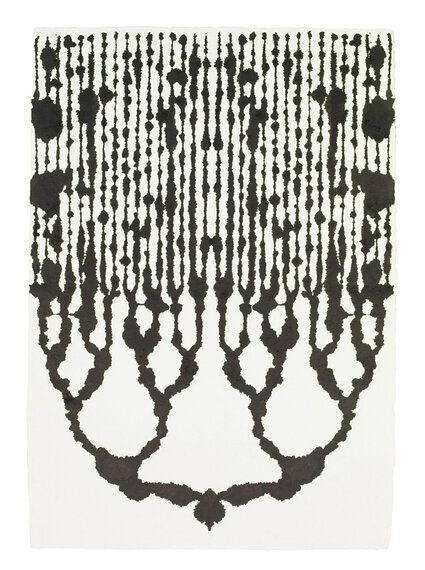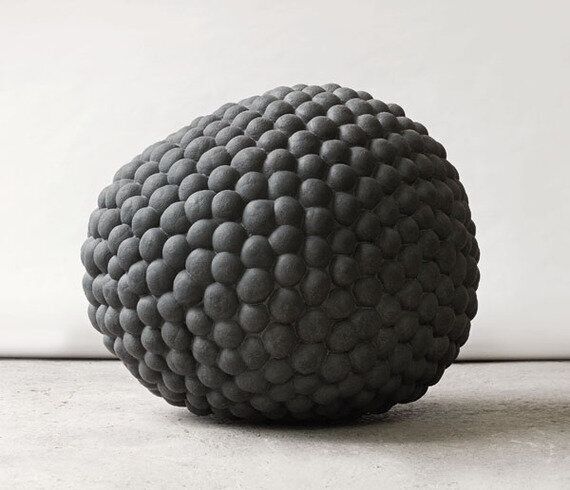Peter Randall-Page's sculptures can be found all over the world. At home, he is represented in the permanent collections of The Tate Gallery and the British Museum. Anyone who has visited the Eden Project will have seen his giant granite sculpture, the Seed, that stands at its heart.
Randall-Page has always been inspired by nature. In particular, his new exhibition entitled Upside Down and Inside Out at Pangolin London is the latest that embodies his fascination with two seemingly disparate forces within the natural world. First, there is the pattern book, the physical set of rules by which nature is governed. On the other hand, there is the seemingly infinite variety that seems to come about within these rules.
I have been talking with Peter Randall-Page about these ideas and how his exhibits reflect them.
"How important are these two forces in nature that so interest you?
"The constant tension between a ubiquitous tendency for spontaneous pattern formation combined with an equally ubiquitous tendency for random variation is what, in a sense, drives the evolutionary process. If one imagined only having pattern and no random variation, nothing would change. And if you only had random variation, well I can't even imagine what that would look like.
"Can you give me an example in nature of these two forces that you mention?"
"Take an oak leaf. We recognise them all as oak leaves and the oak tree yet one would never find two oak leaves the same, just as you'd never find two pebbles the same. That's become the important aspect to my work - trying to understand the dynamics which are driving these patterns and creating them."
"So how have these ideas manifested themselves in this particular exhibition?"

"This exhibition comprises two approaches to that. One is the drawings (above, courtesy Steve Russell) where I've set the terms of the randomness where I'm just allowing the ink to pour in a controlled way. So I put a blob of ink on a piece of paper, tip the paper and direct it in a semi-controlled way. So the terms that I've set have an inbuilt randomness about it. And within that randomness I'm trying to be as controlled as I possibly can with these simple mathematical divisions starting with a kind of seed form and then branching into twos, into fours, and eights so on. And they're made by pouring downhill as if the ink is behaving like a river in a sense so they've got more to do with river deltas and river systems. But then I'm inverting them so that in fact they're dripping upwards. Hence the upside down bit of the title.
"And what about the Inside Out part?"

"The bronze sculptures (above) are very new and are made by taking naturally eroded boulders, having them cast in sand. Then I took the boulder out so you've got a hollow form, and then I worked into the sand from the inside of the moulds. So effectively, I'm eroding something from the inside out. I'm intrigued by the way in which forms that you see in the natural world can be very similar although the processes that produce them are extremely different. If you imagine getting a pebble and a potato, for example, and casting them into plaster or bronze or something, and put them next to each other, you'd be hard-pressed to know which was which. Yet, one has been produced by erosion from the outside while the other produced by growth from the inside, diametrically opposite processes.

"And whereas you've taken the boulder out of this exhibit, you also have granite boulders themselves as exhibits (above) on which you've sculpted a single, continuous groove."
Yes, again I've tried to find ways of working that combine a random element which is the naturally eroded boulder and then imposing on to that some sort of geometric structure which has to adapt and morph and yield to the random shape of the thing. The thing I'm fundamentally interested in is what makes us tick and how we make decisions about things - the human condition if you like."
"So, in a way, are your exhibits a kind of artistic representation of all of our life forces?"
"The key to what, in a sense, I'm trying to draw out in the work is that the world doesn't only enter our consciousness as information, and recognising that's a tree or that's a pebble, it also enters our consciousness as emotion. I'm trying to re-awaken in myself and, hopefully, in other people as well, a fresh look at the world, so you might see things that remind you of things you know in the world but they're a little bit different. They're based on the same underlying principles but you've never quite seen it like that before. My hope is that then when you go out into the world again and see a tree or ordinary things, that perhaps you start to consider them in a slightly different way in terms of the dynamics that have produced all these things around us."
Upside Down and Inside Out is showing at Pangolin, London, King's Place, York Way, London N1 9AG until 4 October 2014.
The images are used with the permission of Pangolin London.